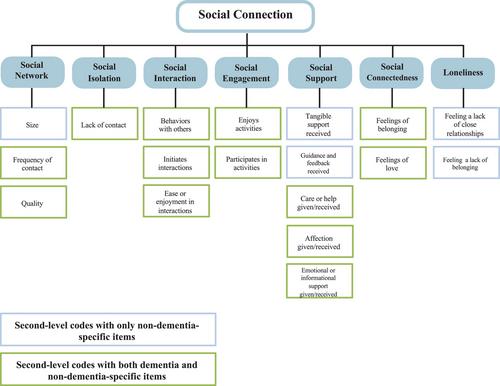Assessing social connection for long-term care home residents: A scoping review of measure content
Abstract
INTRODUCTION
Social connection comprises distinct but interrelated aspects describing how individuals connect to each other. Various measures have assessed multiple aspects of social connection in long-term care (LTC) home populations, but they use inconsistent terminology, making it unclear what aspects are measured. This scoping review describes how social connection is assessed by measures that have been used in LTC home residents.
METHODS
This review followed the Preferred Reporting Items for Systematic reviews and Meta-Analyses extension for Scoping Reviews (PRISMA-ScR) guidelines. Two systematic literature searches combining search terms for social connection AND LTC home residents AND measurement properties were conducted in eight electronic databases from inception to April 2022. Included studies reported the development or psychometric testing of measures which assessed social connection in LTC home residents. A content analysis with a deductive-inductive approach was used to analyze the measures’ content and an adapted Framework Method was used for data management. Findings report each measure's items and the assessed aspects of social connection. Dementia and non-dementia-specific measures had content, administration, and scoring compared.
RESULTS
From 8753 records, 58 studies reporting on 14 dementia-specific and 28 non-dementia-specific social connection measures were identified, including complete measures, subscales, and single items. These measures assessed social network (52.4%), social isolation (11.9%), social interaction (47.6%), social engagement (31.0%), social support (33.3%), social connectedness (21.4%), and loneliness (9.5%). A total of 27 (64.3%) of the measures included more than one aspect of social connection. Dementia-specific measures most often assessed social interaction whereas non-dementia-specific measures most often assessed social network, social interaction, and social support. Dementia-specific measures typically relied on a proxy response, whereas non-dementia-specific measures more often used self-report.
DISCUSSION
Existing social connection measures in LTC home settings operationalize seven aspects of social connection and differ according to the target population (dementia or non-dementia-specific). These findings will inform future measure selection and development.
Highlights
- Social connection is important to long-term care (LTC) home residents’ quality of life.
- Social connection has been assessed by quantifying/describing relationships.
- Existing measures usually assess more than one aspect of social connection.
- These aspects cover several interlinked observed or experienced domains.
- Dementia and non-dementia-specific measures differ in assessing social connection.



 求助内容:
求助内容: 应助结果提醒方式:
应助结果提醒方式:


